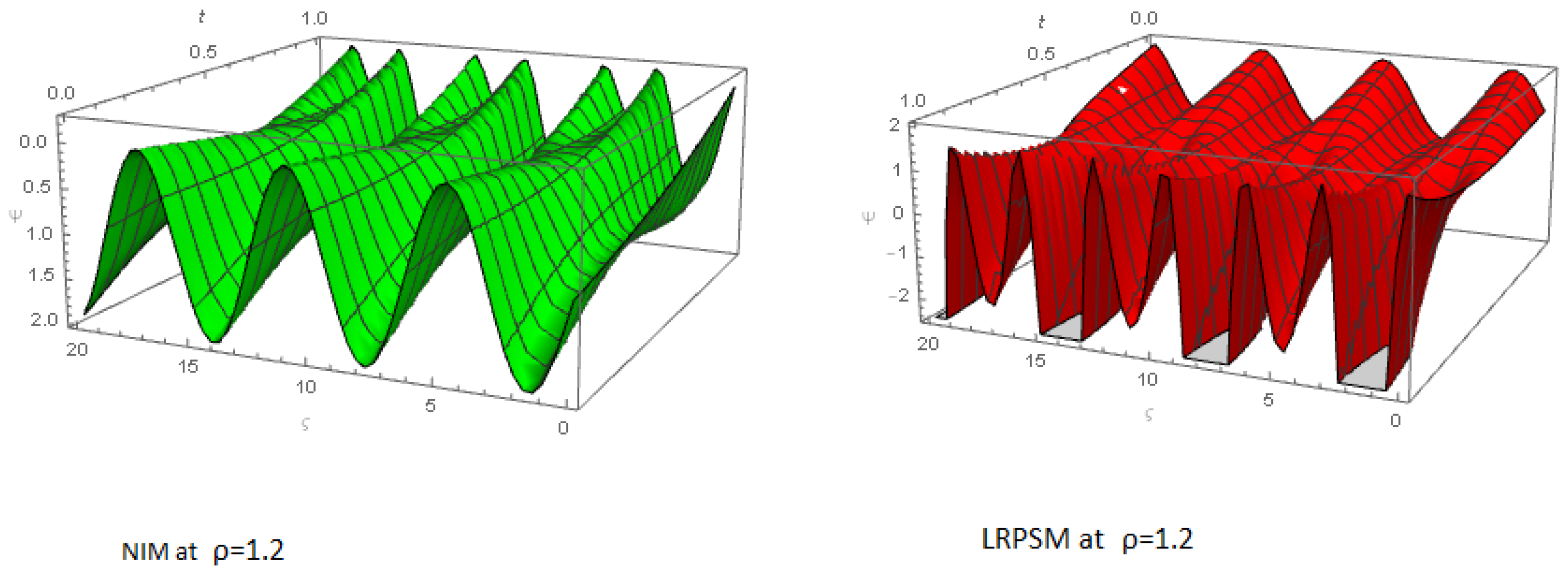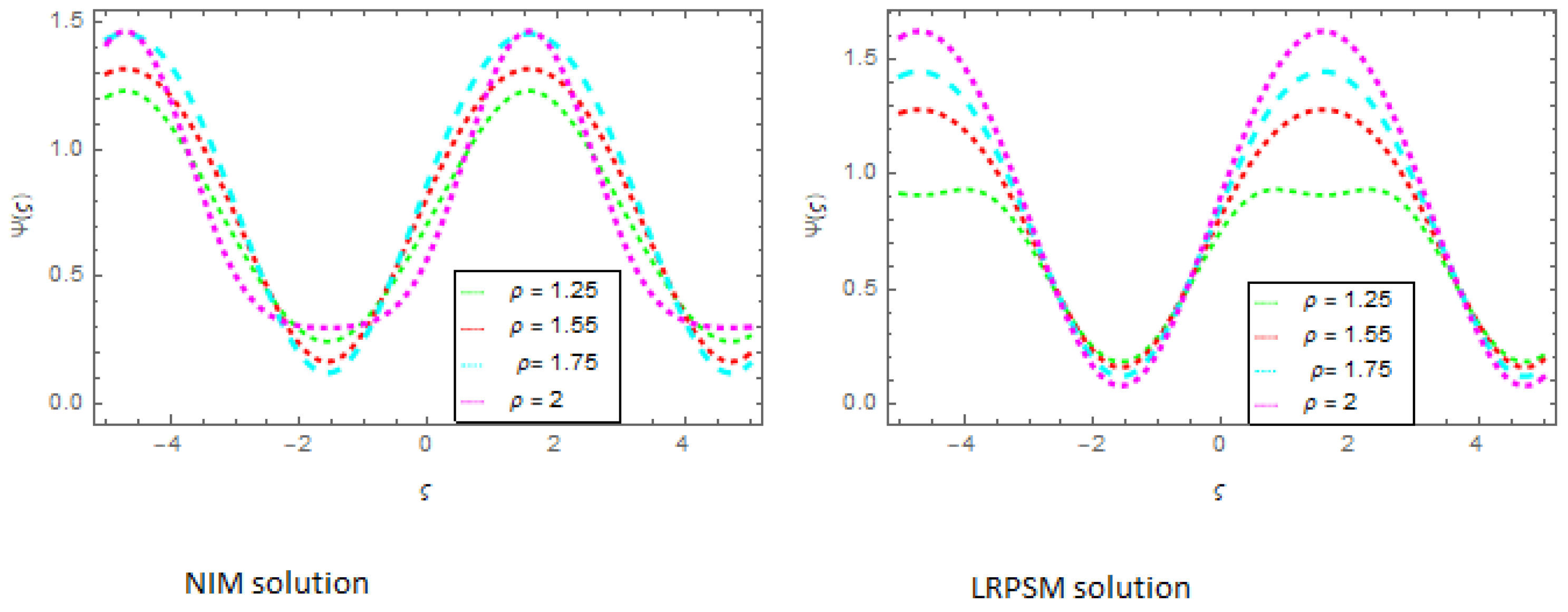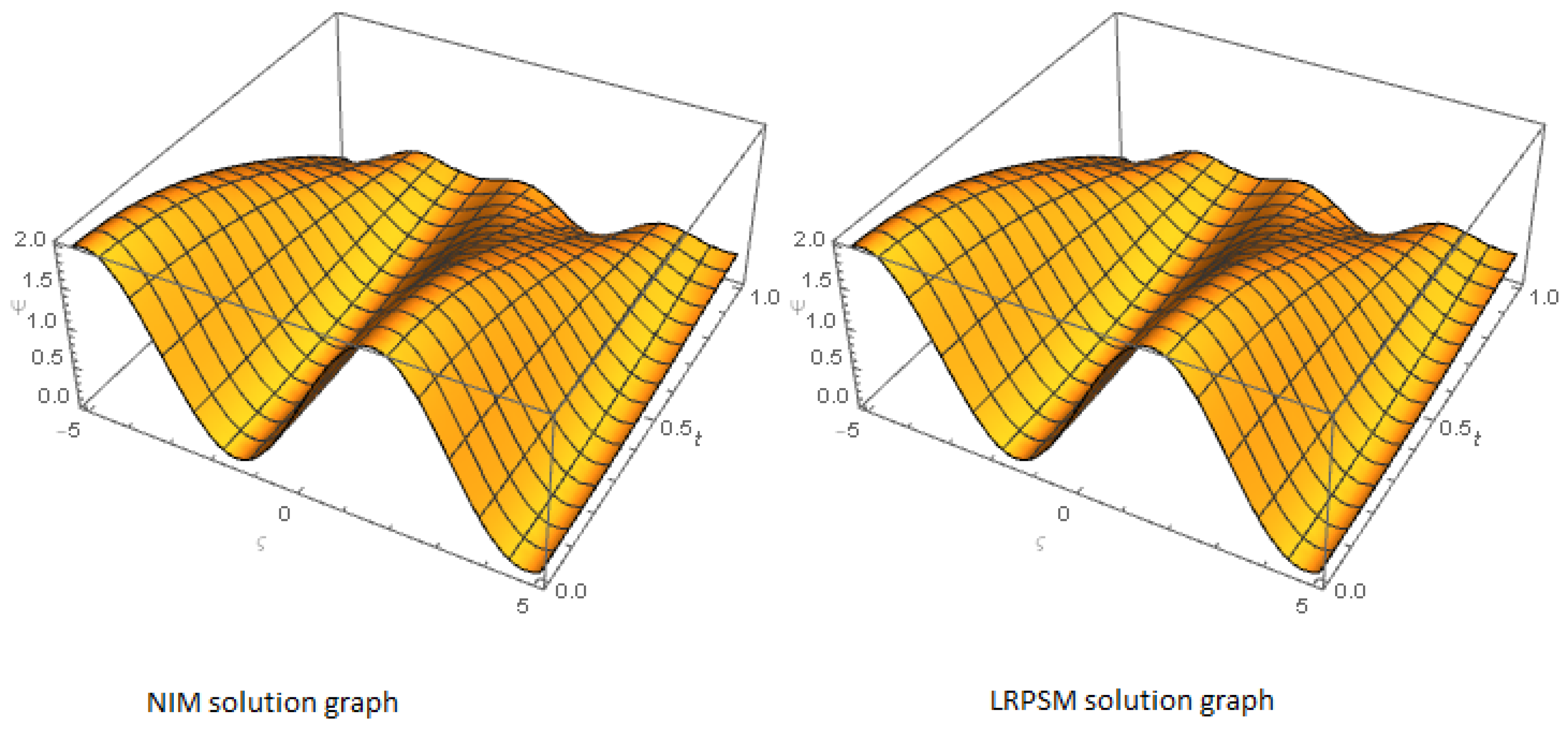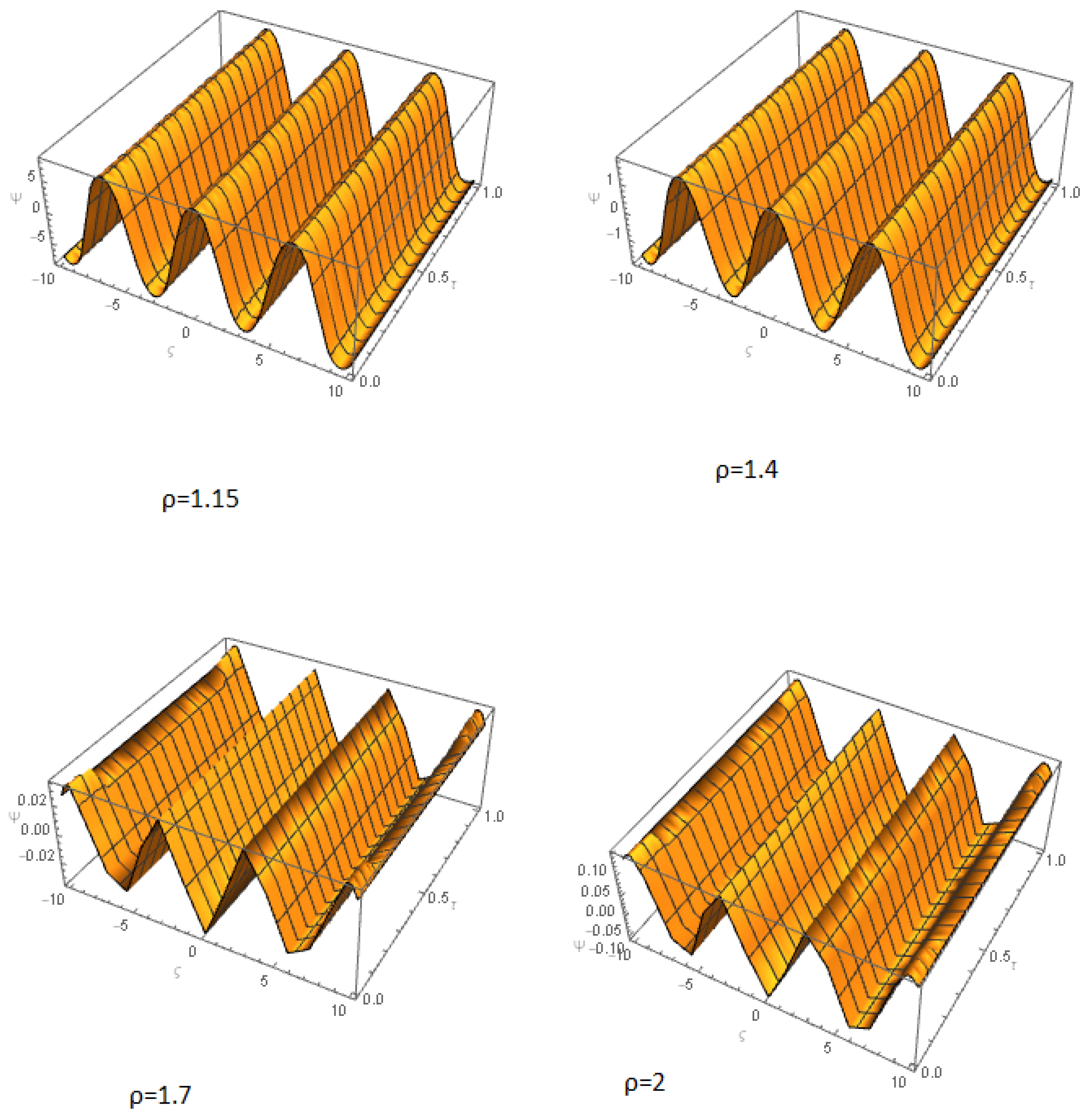Investigating the Impact of Fractional Non-Linearity in the Klein–Fock–Gordon Equation on Quantum Dynamics
Abstract
:1. Introduction
2. Fundamental Definitions
- 1.
- .
- 2.
- .
- 3.
- .
3. Road Map of RPSTM
- and for each
- .
4. Basic Idea of New Iterative Method
5. Numerical Problem
- Solution by LRPSM
- Solution by NIM
- Solution by LRPSM
- Solution by NIM
6. Conclusions
Author Contributions
Funding
Data Availability Statement
Acknowledgments
Conflicts of Interest
References
- Momani, S.; Shawagfeh, N.T. Decomposition method for solving fractional Riccati differential equations. Appl. Math. Comput. 2006, 182, 1083–1092. [Google Scholar] [CrossRef]
- Podlubny, I. Fractional Differential Equations: An introduction to Fractional Derivatives, Fractional Differential Equations, to Methods of Their Solution and Some of Their Applications; Academic Press: New York, NY, USA, 1999. [Google Scholar]
- Jafari, H.; Seifi, S. Homotopy Analysis Method for solving linear and nonlinear fractional diffusion-wave equation. Commun. Nonlinear. Sci. Numer. Simul. 2009, 14, 2006–2012. [Google Scholar] [CrossRef]
- Izadi, M.; Srivastava, H.M. A discretization approach for the nonlinear fractional logistic equation. Entropy 2020, 22, 1328. [Google Scholar] [CrossRef] [PubMed]
- Kiryakova, S.V. Multiple (multiindex) Mittag–Leffler functions and relations to generalized fractional calculus. J. Comput. Appl. Math. 2000, 118, 441–452. [Google Scholar] [CrossRef] [Green Version]
- Oldham, K.B.; Spanier, J. The Fractional Calculus; Academic Press: New York, NY, USA, 1974. [Google Scholar]
- Pitolli, F.; Sorgentone, C.; Pellegrino, E. Approximation of the Riesz-Caputo derivative by cubic splines. Algorithms 2022, 15, 69. [Google Scholar] [CrossRef]
- Diethelm, K.; Ford, N.J.; Freed, A.D. A predictor-corrector approach for the numerical solution of fractional differential equation. Nonlinear Dyn. 2002, 29, 3–22. [Google Scholar] [CrossRef]
- Kilbas, A.A.; Trujillo, J.J. Differential equations of fractional order: Methods, results problems. Appl. Anal. 2001, 78, 153–192. [Google Scholar] [CrossRef]
- Kemple, S.; Beyer, H. Global and Causal Solutions of Fractional Differential Equations, Transform Methods and Special Functions: Varna 96. In Proceedings of the 2nd International Workshop (SCTP), Singapore, 23–30 August 1996; Volume 96, pp. 210–216. [Google Scholar]
- Li, X.; Dong, Z.; Wang, L.; Niu, X.; Yamaguchi, H.; Li, D.; Yu, P. A magnetic field coupling fractional step lattice Boltzmann model for the complex interfacial behavior in magnetic multiphase flows. Appl. Math. Model. 2023, 117, 219–250. [Google Scholar] [CrossRef]
- Sun, L.; Hou, J.; Xing, C.; Fang, Z. A Robust Hammerstein-Wiener Model Identification Method for Highly Nonlinear Systems. Processes 2022, 10, 2664. [Google Scholar] [CrossRef]
- Xu, S.; Dai, H.; Feng, L.; Chen, H.; Chai, Y.; Zheng, W.X. Fault Estimation for Switched Interconnected Nonlinear Systems with External Disturbances via Variable Weighted Iterative Learning. IEEE Trans. Circuits Syst. II Express Briefs 2023. [Google Scholar] [CrossRef]
- Guo, F.; Zhou, W.; Lu, Q.; Zhang, C. Path extension similarity link prediction method based on matrix algebra in directed networks. Comput. Commun. 2022, 187, 83–92. [Google Scholar] [CrossRef]
- Liu, Y.; Xu, K.; Li, J.; Guo, Y.; Zhang, A.; Chen, Q. Millimeter-Wave E-Plane Waveguide Bandpass Filters Based on Spoof Surface Plasmon Polaritons. IEEE Trans. Microw. Theory Tech. 2022, 70, 4399–4409. [Google Scholar] [CrossRef]
- Xu, K.; Guo, Y.; Liu, Y.; Deng, X.; Chen, Q.; Ma, Z. 60-GHz Compact Dual-Mode On-Chip Bandpass Filter Using GaAs Technology. IEEE Electron Device Lett. 2021, 42, 1120–1123. [Google Scholar] [CrossRef]
- Dai, B.; Zhang, B.; Niu, Z.; Feng, Y.; Liu, Y.; Fan, Y. A novel ultrawideband branch waveguide coupler with low amplitude imbalance. IEEE Trans. Microw. Theory Tech. 2022, 70, 3838–3846. [Google Scholar] [CrossRef]
- Feng, Y.; Zhang, B.; Liu, Y.; Niu, Z.; Fan, Y.; Chen, X. A D-Band Manifold Triplexer with High Isolation Utilizing Novel Waveguide Dual-Mode Filters. IEEE Trans. Terahertz Sci. Technol. 2022, 12, 678–681. [Google Scholar] [CrossRef]
- Naeem, M.; Yasmin, H.; Shah, N.A.; Nonlaopon, K. Investigation of Fractional Nonlinear Regularized Long-Wave Models via Novel Techniques. Symmetry 2023, 15, 220. [Google Scholar] [CrossRef]
- Naeem, M.; Yasmin, H.; Shah, N.A.; Chung, J.D. A Comparative Study of Fractional Partial Differential Equations with the Help of Yang Transform. Symmetry 2023, 15, 146. [Google Scholar] [CrossRef]
- Alderremy, A.A.; Shah, R.; Shah, N.A.; Aly, S.; Nonlaopon, K. Comparison of two modified analytical approaches for the systems of time fractional partial differential equations. AIMS Math. 2023, 8, 7142–7162. [Google Scholar] [CrossRef]
- Sunthrayuth, P.; Naeem, M.; Shah, N.A.; Chung, J.D. On the Solution of Fractional Biswas-Milovic Model via Analytical Method. Symmetry 2023, 15, 210. [Google Scholar] [CrossRef]
- Cao, Y.; Nikan, O.; Avazzadeh, Z. A localized meshless technique for solving 2D nonlinear integro-differential equation with multi-term kernels. Appl. Numer. Math. 2023, 183, 140–156. [Google Scholar] [CrossRef]
- Jassim, H.K.; Shareef, M.A. On approximate solutions for fractional system of differential equations with Caputo-Fabrizio fractional operator. J. Math. Comput. Sci. 2021, 23, 58–66. [Google Scholar] [CrossRef]
- Akram, T.; Abbas, M.; Ali, A. A numerical study on time fractional Fisher equation using an extended cubic B-spline approximation. J. Math. Comput. Sci. 2021, 22, 85–96. [Google Scholar] [CrossRef]
- Salama, F.M.; Ali, N.H.M.; Abd Hamid, N.N. Fast O (N) hybrid Laplace transform-finite difference method in solving 2D time fractional diffusion equation. J. Math. Comput. Sci. 2021, 23, 110–123. [Google Scholar] [CrossRef]
- Jin, H.; Wang, Z.; Wu, L. Global dynamics of a three-species spatial food chain model. J. Differ. Equ. 2022, 333, 144–183. [Google Scholar] [CrossRef]
- Jin, H.; Wang, Z. Boundedness, blowup and critical mass phenomenon in competing chemotaxis. J. Differ. Equ. 2016, 260, 162–196. [Google Scholar] [CrossRef]
- Song, F.; Liu, Y.; Shen, D.; Li, L.; Tan, J. Learning Control for Motion Coordination in Wafer Scanners: Toward Gain Adaptation. IEEE Trans. Ind. Electron. 2022, 69, 13428–13438. [Google Scholar] [CrossRef]
- Xie, X.; Wang, T.; Zhang, W. Existence of solutions for the (p,q)-Laplacian equation with nonlocal Choquard reaction. Appl. Math. Lett. 2023, 135, 108418. [Google Scholar] [CrossRef]
- Zhang, Y.; He, Y.; Wang, H.; Sun, L.; Su, Y. Ultra-Broadband Mode Size Converter Using On-Chip Metamaterial-Based Luneburg Lens. ACS Photonics 2021, 8, 202–208. [Google Scholar] [CrossRef]
- Khan, N.A.; Rasheed, S. Analytical solutions of linear and nonlinear Klein-Fock-Gordon equation. Nonlinear Eng.-Model. Appl. 2015, 4, 43–48. [Google Scholar] [CrossRef]
- Yusufoglu, E. The variational iteration method for studying the Klein-Gordon equation. Appl. Math. Lett. 2008, 21, 669–674. [Google Scholar] [CrossRef] [Green Version]
- Aruna, K.; Ravi Kanth, A.S.V. Two-dimensional differential transform method and modified differential transform method for solving nonlinear fractional Klein-Gordon equation. Nat. Acad. Sci. Lett. 2014, 37, 163–171. [Google Scholar] [CrossRef]
- Ravi Kanth, A.S.V.; Aruna, K. Differential transform method for solving the linear and nonlinear Klein-Gordon equation. Comput. Phys. Commun. 2009, 180, 708–711. [Google Scholar] [CrossRef]
- Veeresha, P.; Prakasha, D.G.; Kumar, D. An efficient technique for nonlinear time-fractional Klein-Fock-Gordon equation. Appl. Math. Comput. 2020, 364, 124637. [Google Scholar] [CrossRef]
- Kumar, D.; Singh, J.; Kumar, S. Numerical computation of Klein-Gordon equations arising in quantum field theory by using homotopy analysis transform method. Alex. Eng. J. 2014, 53, 469–474. [Google Scholar] [CrossRef] [Green Version]
- Shymanskyi, V.; Sokolovskyy, Y. Variational Formulation of the Stress-Strain Problem in Capillary-Porous Materials with Fractal Structure. In Proceedings of the 2020 IEEE 15th International Conference on Computer Sciences and Information Technologies (CSIT), Zbarazh, Ukraine, 23–26 September 2020; Volume 1, pp. 1–4. [Google Scholar]
- Arqub, O.A.; El-Ajou, A.; Momani, S. Constructing and predicting solitary pattern solutions for nonlinear timefractional dispersive partial differential equations. J. Comput. Phys. 2015, 293, 385–399. [Google Scholar] [CrossRef]
- Arqub, O.A.; El-Ajou, A.; Bataineh, A.S.; Hashim, I. A representation of the exact solution of generalized Lane-Emden equations using a new analytical method. In Abstract and Applied Analysis; Hindawi: London, UK, 2013; p. 10. [Google Scholar]
- Ban, Y.; Liu, M.; Wu, P.; Yang, B.; Liu, S.; Yin, L.; Zheng, W. Depth Estimation Method for Monocular Camera Defocus Images in Microscopic Scenes. Electronics 2022, 11, 2012. [Google Scholar] [CrossRef]
- Lu, S.; Ban, Y.; Zhang, X.; Yang, B.; Liu, S.; Yin, L.; Zheng, W. Adaptive control of time delay teleoperation system with uncertain dynamics. Front. Neurorobot. 2022, 16, 928863. [Google Scholar] [CrossRef]
- Liu, M.; Gu, Q.; Yang, B.; Yin, Z.; Liu, S.; Yin, L.; Zheng, W. Kinematics Model Optimization Algorithm for Six Degrees of Freedom Parallel Platform. Appl. Sci. 2023, 13, 3082. [Google Scholar] [CrossRef]
- Qin, X.; Liu, Z.; Liu, Y.; Liu, S.; Yang, B.; Yin, L.; Liu, M.; Zheng, W. User OCEAN Personality Model Construction Method Using a BP Neural Network. Electronics 2022, 11, 3022. [Google Scholar] [CrossRef]
- Ye, R.; Liu, P.; Shi, K.; Yan, B. State Damping Control: A Novel Simple Method of Rotor UAV with High Performance. IEEE Access 2020, 8, 214346–214357. [Google Scholar] [CrossRef]
- Arqub, O.A.; Abo-Hammour, Z.; Al-Badarneh, R.; Momani, S. A reliable analytical method for solving higher-order initial value problems. Discret. Dyn. Nat. Soc. 2013, 2013, 12. [Google Scholar] [CrossRef]
- El-Ajou, A.; Arqub, O.A.; Momani, S.; Baleanu, D.; Alsaedi, A. A novel expansion iterative method for solving linear partial differential equations of fractional order. Appl. Math. Comput. 2015, 257, 119–133. [Google Scholar] [CrossRef]
- He, H.M.; Peng, J.G.; Li, H.Y. Iterative approximation of fixed point problems and variational inequality problems on Hadamard manifolds. UPB Bull. Ser. A 2022, 84, 25–36. [Google Scholar]
- Liu, L.; Wang, J.; Zhang, L.; Zhang, S. Multi-AUV Dynamic Maneuver Countermeasure Algorithm Based on Interval Information Game and Fractional-Order DE. Fractal Fract. 2022, 6, 235. [Google Scholar] [CrossRef]
- Cheng, Z.L.; Ma, L.; Liu, Z. Hydrothermal-assisted grinding route for WS2 quantum dots (QDs) from nanosheets with preferable tribological performance. Chin. Chem. Lett. 2021, 32, 583–586. [Google Scholar] [CrossRef]
- Mukhtar, S.; Noor, S. The Numerical Investigation of a Fractional-Order Multi-Dimensional Model of Navier–Stokes Equation via Novel Techniques. Symmetry 2022, 14, 1102. [Google Scholar] [CrossRef]
- Al-Sawalha, M.M.; Agarwal, R.P.; Shah, R.; Ababneh, O.Y.; Weera, W. A reliable way to deal with fractional-order equations that describe the unsteady flow of a polytropic gas. Mathematics 2022, 10, 2293. [Google Scholar] [CrossRef]
- Shah, N.A.; Alyousef, H.A.; El-Tantawy, S.A.; Chung, J.D. Analytical Investigation of Fractional-Order Korteweg-De-Vries-Type Equations under Atangana-Baleanu-Caputo Operator: Modeling Nonlinear Waves in a Plasma and Fluid. Symmetry 2022, 14, 739. [Google Scholar] [CrossRef]
- Alquran, M.; Ali, M.; Alsukhour, M.; Jaradat, I. Promoted residual power series technique with Laplace transform to solve some time-fractional problems arising in physics. Results Phys. 2022, 19, 103667. [Google Scholar] [CrossRef]





| NIM | LRPSM | NIM Absolute Error | LRPSM Absolute Error | |
|---|---|---|---|---|
| −1 | 0.161830 | 0.161830 | −1.45015 | −4.84885 |
| −0.9 | 0.219649 | 0.219649 | −9.26956 | −4.20187 |
| −0.8 | 0.285219 | 0.285219 | −1.81174 | −3.5230 8× |
| −0.7 | 0.357872 | 0.357872 | −2.77101 | −2.83933 |
| −0.6 | 0.436869 | 0.436869 | −3.76338 | −0.21777 |
| −0.5 | 0.521411 | 0.521411 | −0.47337 | −1.56448 |
| −0.4 | 0.610642 | 0.610642 | −5.61359 | −1.02418 |
| 0.3 | 0.703661 | 0.703661 | −6.32343 | −5.78561 |
| −0.2 | 0.799530 | 0.799530 | −0.67759 | −2.45844 |
| −0.1 | 0.897287 | 0.897287 | −6.88098 | −3.99668 |
| 0 | 0.995950 | 0.995950 | −6.55214 | 2.99566 |
| 0.1 | 1.094530 | 1.094530 | −5.71342 | −3.99701 |
| 0.2 | 1.192050 | 1.192050 | −4.30678 | −2.48219 |
| 0.3 | 1.287540 | 1.287540 | −2.29905 | −5.87823 |
| 0.4 | 1.380040 | 1.380040 | 3.11952 | −1.04656 |
| 0.5 | 1.468640 | 1.468640 | 3.49319 | −1.60733 |
| 0.6 | 1.552470 | 1.552470 | 7.17426 | −2.24876 |
| 0.7 | 1.630690 | 1.630690 | 0.112480 | −2.94595 |
| 0.8 | 1.702550 | 1.702550 | 0.155738 | −0.36714 |
| 0.9 | 1.767320 | 1.767320 | 0.199841 | −4.39613 |
| 1 | 1.824380 | 1.824380 | 0.242930 | −5.09083 |
| NIM | LRPSM | NIM Absolute Error | LRPSM Absolute Error | |
|---|---|---|---|---|
| −1 | 0.161830 | 0.161830 | −2.450 | −5.848 |
| −0.9 | 0.428538 | 0.428538 | −8.269 | −5.201 |
| −0.8 | 0.384187 | 0.384187 | −2.811 | −4.523 |
| −0.7 | 0.246887 | 0.246887 | −3.771 | −3.839 |
| −0.6 | 0.535480 | 0.535480 | −4.763 | −1.217 |
| −0.5 | 0.432147 | 0.432147 | −1.473 | −2.564 |
| −0.4 | 0.511532 | 0.511532 | −6.613 | −2.024 |
| 0.3 | 0.612678 | 0.612678 | −7.323 | −4.785 |
| −0.2 | 0.688420 | 0.688420 | −1.677 | −3.458 |
| −0.1 | 0.786217 | 0.786217 | −7.880 | −4.996 |
| 0 | 0.885960 | 0.885960 | −7.552 | 3.995 |
| 0.1 | 1.189150 | 1.189150 | −4.713 | −4.997 |
| 0.2 | 1.289131 | 1.289131 | −3.306 | −3.482 |
| 0.3 | 1.376450 | 1.376450 | −3.299 | −4.878 |
| 0.4 | 1.470030 | 1.470030 | 4.119 | −2.046 |
| 0.5 | 1.358941 | 1.358941 | 4.493 | −2.607 |
| 0.6 | 1.664810 | 1.664810 | 8.174 | −3.248 |
| 0.7 | 1.781581 | 1.781581 | 1.1124 | −3.945 |
| 0.8 | 1.812441 | 1.812441 | 1.1557 | −1.367 |
| 0.9 | 1.805231 | 1.805231 | 1.1998 | −5.396 |
| 1 | 1.786200 | 1.786200 | 1.2328 | −6.090 |
Disclaimer/Publisher’s Note: The statements, opinions and data contained in all publications are solely those of the individual author(s) and contributor(s) and not of MDPI and/or the editor(s). MDPI and/or the editor(s) disclaim responsibility for any injury to people or property resulting from any ideas, methods, instructions or products referred to in the content. |
© 2023 by the authors. Licensee MDPI, Basel, Switzerland. This article is an open access article distributed under the terms and conditions of the Creative Commons Attribution (CC BY) license (https://creativecommons.org/licenses/by/4.0/).
Share and Cite
Noor, S.; Alshehry, A.S.; Aljahdaly, N.H.; Dutt, H.M.; Khan, I.; Shah, R. Investigating the Impact of Fractional Non-Linearity in the Klein–Fock–Gordon Equation on Quantum Dynamics. Symmetry 2023, 15, 881. https://doi.org/10.3390/sym15040881
Noor S, Alshehry AS, Aljahdaly NH, Dutt HM, Khan I, Shah R. Investigating the Impact of Fractional Non-Linearity in the Klein–Fock–Gordon Equation on Quantum Dynamics. Symmetry. 2023; 15(4):881. https://doi.org/10.3390/sym15040881
Chicago/Turabian StyleNoor, Saima, Azzh Saad Alshehry, Noufe H. Aljahdaly, Hina M. Dutt, Imran Khan, and Rasool Shah. 2023. "Investigating the Impact of Fractional Non-Linearity in the Klein–Fock–Gordon Equation on Quantum Dynamics" Symmetry 15, no. 4: 881. https://doi.org/10.3390/sym15040881





